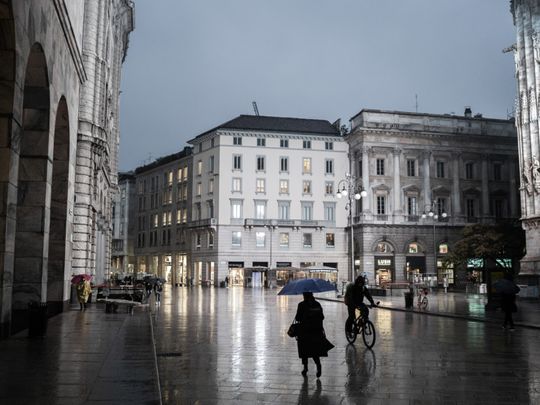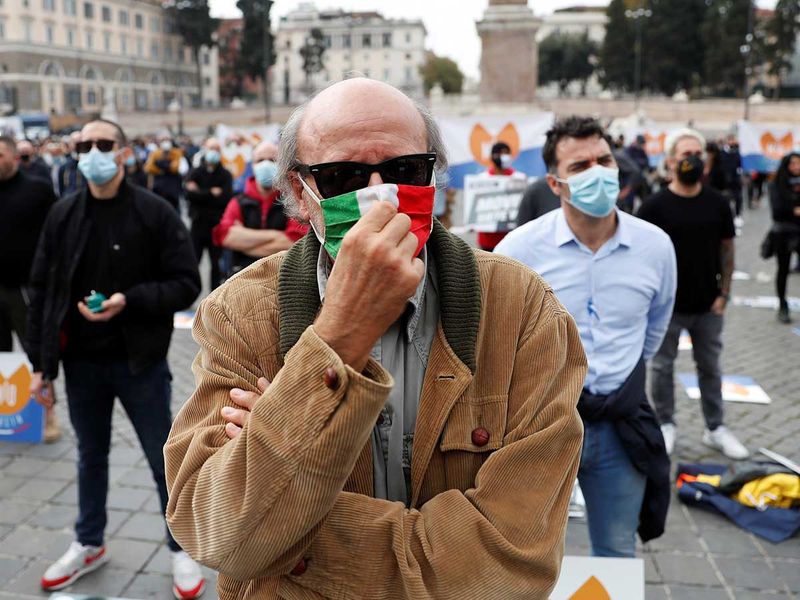
Rome: When the coronavirus first hit Italy, overwhelming the country’s hospitals and prompting the West’s first lockdown, Italians inspired the world with their resilience and civic responsibility, staying home and singing on their balconies. Their reward for months of quarantine was a flattened curve, a gulp of normality and the satisfaction of usually patronising allies pointing to Italy as a model.
Italy is now a long way away from those balcony days and its summer fling with freedom. Instead, as a second wave engulfs Europe and triggers new nationwide lockdowns, Italy has become emblematic of a despair, exhaustion and fear that is spreading throughout the Continent.
France has applied a new national lockdown to contain skyrocketing cases. Germany has put in place softer, but still severe, nationwide restrictions. Ireland has restricted movement and barred visits to other people’s homes. Throughout Europe, governments are scrambling to deliver relief, keep schools open and salvage their economies.
And everywhere, if people are not sick with the virus, they are sick of it. In Italy, the discontent is exploding.
The country that gave the Western world a preview of Covid’s awful human toll — that demonstrated the necessity, and success, of a national lockdown — now stands for something darker. Italy has become a symbol of Europe’s squandered advantages, the impotence of half measures in the face of a virus that does not abide by compromises, and the social and political costs of not making good on promises of relief.
'End of our rope'
Italians, coming down hard from their summer euphoria, are exasperated.
“We’ve reached the end of our rope,” said Emanuele Tudini, whose wife applauded doctors from their apartment window and whose children drew “Everything Will Be OK” rainbows at the beginning of the crisis.

He spoke in his bar in front of the Pantheon in central Rome, where angry cooks in chef hats, restaurateurs and fellow bar owners protested new government restrictions that shut them down after 6pm It was one of dozens of predominantly peaceful protests that have erupted across the country in recent days. “There’s a ton of rage and suffering.”
Italian hospitals, which delivered a searing global preview of the horror to come in March, are again under strain and intensive care units are filling up.
Milan, Italy’s economic engine, is the new capital of its contagion and seems on the brink of quarantine. The poorer and vulnerable south is exposed, and Neapolitans have rioted against early closures imposed to avoid a massacre. Romans are swinging erratically between last-days-of-disco day drinking and holing up during eerily quiet nights.
Unease leads to unrest
All around the country, unease is morphing into unrest, with violent protests breaking out Friday night in Florence. Large crowds in Trieste chant that they just want to work. And demonstrators have taken to the streets in nearly every major Italian city, from Palermo to Bologna to Verona.
Mobsters, hooligans and far-right extremists have exploited the frustration and anger, infiltrating protests in Naples, Turin and Rome and pushing burning dumpsters and tossing Molotov cocktails. The police, on edge and increasingly present, have put down the violence with water cannons.
Italians seem increasingly intolerant of a government that spins out ephemeral emergency decrees with the ease and frequency of a casino dealer.
In October, Prime Minister Giuseppe Conte, who first assured the arrival of a vaccine by December and now promises a “serene” Christmas, said, “I exclude lockdowns and say that after due consideration.”
This week he was less definitive, saying that Italy had entered something he called “Scenario 3” and urged Italians to follow the new measures or else the “virus will spread beyond control.” On Friday, the government prepared for “Scenario 4,” with lockdowns in the most infected regions.
Significant damage
But for many Italians the damage is already significant. Conte announced more relief packages for businesses worth about 5 billion euros this week, and on Friday banned firings through March. The government insists that they are working to cut down on bureaucracy and that the aid will reach Italians much sooner. But its track record of delivering on promises is not promising.
Many workers say they haven’t received unemployment benefits since May. Business owners who once embraced the hashtag, “I Stay Home,” now defiantly type, “I Stay Open.” Education experts are vexed that keeping schools open seems less of a priority than it does in France or Germany.
And only last week, months after Conte’s committee of experts called for more medical staff, did his government get around to beginning the process of hiring thousands of medical workers and contact tracers.
The same government committee of experts in April urged the government to procure more buses to alleviate overcrowding on public transit. Instead, images of overcrowded buses packed Italian media. Conte has said avoiding crowded public transportation is the main driver of the current restrictions.
“The restaurants and bars are safer than the public transportation,” said Sergio Paolantoni, president of the association that organised the Rome protest at the Pantheon, which was coordinated with protests in 23 other cities around the country.
With tourism devastated and lunchtime traffic decimated by workers staying home, he said the 6pm cut-off for restaurants amounted to a death blow. “It’s better to have a total lockdown instead of targeting only us,” he said.
The restrictions were part of new measures that also closed cinemas, gyms and theatres until Nov. 24. The government also required 75% of high school students to return to online learning, and continued bans on large parties, including wedding receptions. But they seem likely to be replaced with stricter measures.
Critics within
Some critics of the government’s response have come from within its own parliamentary majority.
“Better a total lockdown than these half measures,” former Prime Minister Matteo Renzi told reporters this past week. He argued that closing restaurants for dinner but not lunch made no sense, and did nothing to limit infections, but increased unemployment.
The populist opposition also has supported the protests around the country. Matteo Salvini, leader of the nationalist League party and former mask sceptic, showed up in a mask to talk to chefs at the Pantheon protests, where some onlookers jeered him.
Despite previously expressing scepticism about a second wave, Salvini now criticises the government for dallying on its laurels over the summer. If the state of emergency were real, he says, then a total lockdown, not a half measure that targeted business, was in order.
Beyond restrictions
Amid the political jostling, some regions have gone beyond the national restrictions in fear of the virus overwhelming their hospitals.
Campania, the southern region that is home to Naples, where violent protests broke out last week, has banned movement across provincial lines except for work, health or extenuating circumstances. It has also cancelled nursery school and mandated remote learning for students from elementary school to college. Other vulnerable southern regions, including Calabria and Sicily, have also adopted strict measures.
Lombardy, which bore the brunt of the first wave of the virus, is getting walloped again and has imposed curfews and more remote learning. But this time a nightmare scenario is unfolding that was avoided last time — the infection of Milan, with a population of 1.3 million. It now has the country’s highest virus reproduction number, significantly above 2.
“In Milan you can catch the virus by simply entering a cafe or getting on a bus,” Walter Ricciardi, an adviser to Italy’s health minister, said as he called for the city to be locked down. But others oppose going so far.
“It’s a bad decision,” Giuseppe Sala, the mayor of Milan said in a video address, adding to the newspaper Corriere della Sera that he thought the city had at least 10 days before it came to that crossroads.
Many Italians, though, believe that a return to a national lockdown was only a matter of time.
Fabiana Gargioli returned from the protest to her restaurant, Armando al Pantheon, to greet diners for lunch service and to turn away couples seeking to make dinner reservations. She recalled joining millions of Italians in singing “The Sky is Always Bluer” from her balcony in March.
“Now it’s different,” she said. “The money is gone.”








